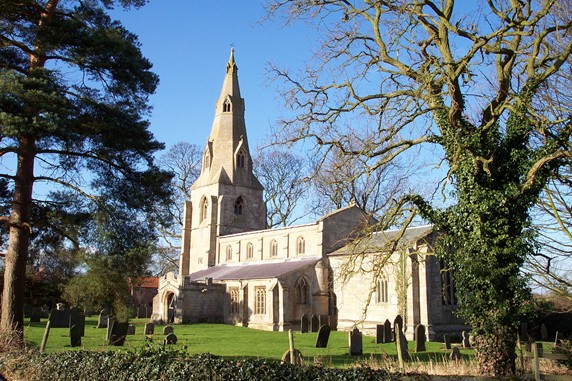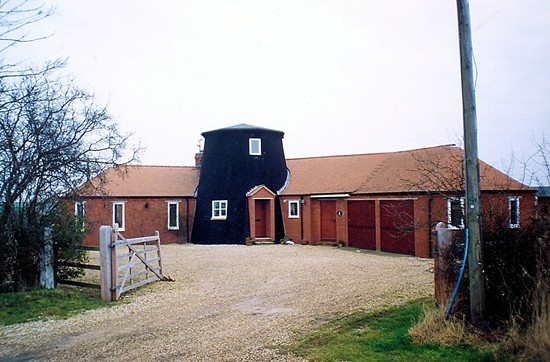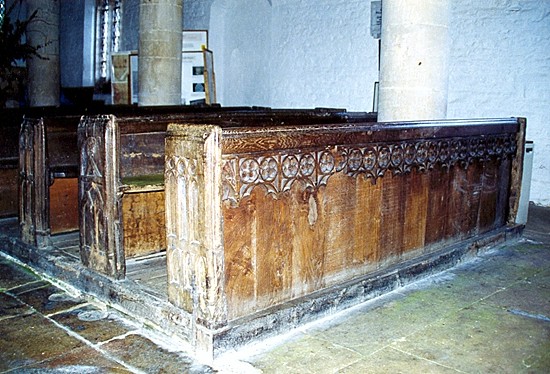|
Pickworth

A visit to
the village church at Pickworth, nine miles north west of Bourne, is to follow in the footsteps of those who love our countryside and our heritage because this building is a time capsule of religious belief in a small rural community that has remained virtually unchanged over the centuries.
The flagstones have been worn uneven by generations of worshippers and the ancient timbers of the pews, the pulpit and communion rail smoothed by the touch of untold hands for this is a living church, a building that has been a pivotal force in the existence of those people who have inhabited this countryside since it was built.
They had a blind and primitive belief, a simple confrontation between good and evil, and each Sunday their parson exhorted them from the pulpit to lead an exemplary life or boil in the cauldron of God's wrath. Fear of Satan was much in evidence and a door was incorporated in the wall on the north side of the church which was left open at baptisms in order that the evil spirit could loose itself in the shadows. It has now been blocked off to keep out the cold and stop the draughts.
There have been alterations and additions to the building over the centuries but the very atmosphere is one of an enduring faith and a few moments of quiet contemplation in an empty church enables one conjure up the ghosts from the past when life was harder, though less hurried, and piety was a necessary part of the daily round.
St Andrew's Church stands in the unfrequented stone belt of South Lincolnshire and was largely rebuilt, apart from the tower, about 1358 by the Pickworth family and ten years later the Black Death had swept away one third of the population, including most of the elderly. The church is built almost entirely in the Decorated style of English Gothic architecture of the 13th and 14th centuries, with a broached spire and an unrestored interior of old pews and a plain 13th century font, whilst an ancient sedilia and a piscina with carved leaves and ugly heads are still in evidence. The south door has been there for 600 years and its decorative ironwork forms the letter C above and below in honour of St Clement the Martyr (100 A D), the patron saint of the smith. There is a mediaeval rood screen of the most delicate workmanship, a two-decker pulpit still with its hour glass stand from 1693, altar rails dated 1767 and important wall paintings from the 14th century.
The rood screen under the chancel arch is 600 years old and by 1964 it was in a very poor condition with the lower section collapsing and parts of the decoration missing but it was restored with consummate skill by Mr J H Palin who reproduced the missing coving, destroyed in 1566, redecorated parts hidden by unwanted coats of varnish and replaced the decaying beam on which the screen rested. Like the 14th century woodcarver who created this work, Mr Palin was left-handed and he was later honoured for his fine craftsmanship with an award from the Architects' Association.
The figure of an early 15th century headless female saint still stands on its corbel and there are beautifully furnished chapels. Above all, there are the wall paintings and they are really what matters at Pickworth
but as so often in England they are far too badly preserved to be enjoyed. The
murals were originally painted circa 1380 but were partly obscured during
re-roofing a century later and covered by white paint circa 1540. They were
re-discovered during the Second World War when a bomb fell near the church and
displaced large chunks of the whitewash. Mr E Clive Rouse set to work and by
carefully chipping away the plaster, gradually uncovered the paintings which
were finally revealed in all their glory when his work was completed in 1950,
depicting scenes from the Bible, the lives of the saints and examples of the
moralities.
If one
wants to enjoy or indeed to study them, one must look at reproductions and
fortunately the church provides a clear broadsheet guide for visitors. Doom, or
the Last Judgement, is over the chancel arch depicting more than sixty figures
and on the nave south wall three figures are sizzling in that very cauldron but
opposite is first the ascending Christ, then the Three Quick and the Three Dead,
then the friendly figure of St Christopher while one of the north arcade
spandrels contains another picture showing the Weighing of Souls. They are all
precious as examples of 14th century art and devotion.
In
2005, preservation work was carried out at the church with the help of a £15,000
grant from the government's Rural Enterprise Scheme administered by Defra (the
Department for Environment, Food and Rural Affairs). The project involved the
replacement of roof timbers and the laying of new slate tiles which was carried
out by specialist contractors in close consultation with English Heritage who
were anxious to protect the roosting and breeding site of a colony of rare
pipistrelle and Natterer's bats that have made their home in the building.
This church is a favourite of Prince Charles and he came here to see the wall paintings in 1971 while learning to fly at nearby R A F Cranwell but found it locked although he returned in 1988 when his visit had a more successful outcome. If anyone wishes to make the pilgrimage to Pickworth, they will find their visit well worthwhile and the key to the church is now available from the house opposite.
|
PHOTO ALBUM |
|
 |
|
The manor house at Pickworth dates from between 1530 and 1600. The property, which has the original dew-pond in the grounds, was derelict when the present owner bought it nine years ago and it has since been well restored. The house was originally a farmstead and part of the Armin estate which is now being researched by the owner who has found references to it as far back as 1454. |
 |
|
This small tower mill in Mill Lane was built in the early 19th century by
the millwright Ingledew to replace a post mill and had two common and two
spring sales for milling flour, cereals and animal feed. It ceased working
in the early 20th century and was used for a time as a cheese factory but
has now been reduced to a two-storey stump incorporated into a modern
home. |
|
FROM THE ARCHIVES
As some bricklayers were removing the thatch
from an old farmhouse in the parish of Pickworth a few days ago,
they discovered an old coat in a very dilapidated condition which it
is believed, belonged to a man named Wells, who about 60 years ago
concealed himself in the roof of the house, he being wanted on a
charge of issuing forged notes. The constables, however, succeeded
in discovering Wells' hiding place and he was afterwards removed to
Lincoln, tried and executed. - news report from the Stamford
Mercury, Friday 17th September 1869. |
REVISED JULY 2015
See
also
Charles Sharpe V C A Pickworth Diary
A charitable appeal

Go to:
Main Index Villages
Index
|








